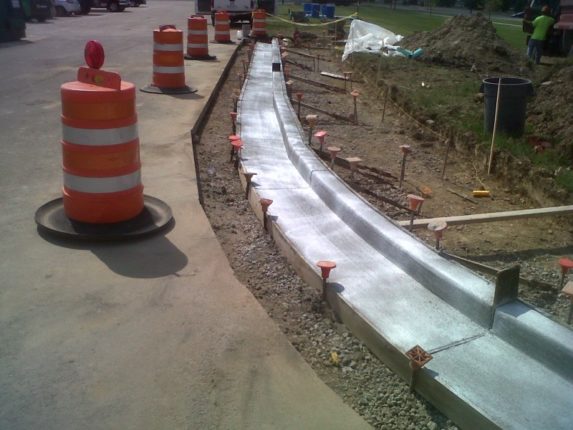Concrete curbing serves a variety of functions. It can serve as a barrier to vegetation, direct runoff into storm drains, define the boundaries of the property and discourage driving onto restricted areas. Curbs provide a formal, finished appearance to the pavement that many people find aesthetically pleasing.
Concrete Curbing
There are several different types of curbs that can be installed for specific purposes. For example, a curb with a sloped face can allow vehicles to drive over it at a low speed, while a curb with a vertical face strongly discourages vehicles from attempting to drive over it. A square-edged curb poses less of a tripping hazard to pedestrians, while a high curb with a concave face and sloped lower portion provides greater protection against vehicles. In residential neighborhoods featuring grassy setbacks and numerous driveways, curbs are usually rounded, making them easier for vehicles to drive over them.
Curbs that are used to direct the flow of water are typically combined with a gutter. The gutter may be constructed where the roadway and curb meet. Gutters may also be cast as part of the curb, or the curb and gutter may be integrated as part of the pavement.
The height of the curb depends on function and aesthetics. The height that is visible above the surface of the pavement is called the reveal. Most reveals are between 4 and 8 inches. Curb ramps designed to make pavement accessible to the handicapped typically have no reveal, but ADA guidelines permit a reveal of up to a quarter of an inch.
The width of the curb face can vary. In the United States, most curb faces are between 6 and 8 inches when measured at their widest points. However, customized curbs that are narrower or wider are offered by many contractors.
After concrete curbs are installed, it is important to keep water away for 48 to 72 hours. If the curbs are exposed to water before the initial curing process is complete, the concrete may become permanently discolored or blotchy.
Repairing Concrete Curbs
Most damage to concrete curbs is caused by abuse. Vehicles drive over curbs that were installed to prevent just that behavior, trucks scrape against the curb facing or storm drains become clogged and water is allowed to back up under the curbing. Trees and large shrubs growing near the curbs may send out roots that lift a section of the curbing out of position. Fortunately, repairing damaged curbs is usually fast and economical.
Maintaining Concrete Curbs
Maintenance on concrete curbs is not extensive. Should cracks develop, you want to have them repaired as soon as possible. If you have curb markings to indicate fire zones, no-parking areas or loading zones, you should ensure that the paint is kept in good repair and that the curb is repainted when visibility or appearance is negatively impacted.
Call Alpha for Your Curbing Needs
Alpha Paving is a full-service paving company offering a wide range of services to commercial and residential property managers in Central Texas. Our loyal customers include municipalities, subdivisions, shopping centers, retailers, religious institutions, airports, HOAs, apartment complexes, manufacturing facilities, schools, office complexes, hotels and entertainment venues. Our services include concrete paving and repair, pavement markings, asphalt paving and repair, sealcoating, asphalt overlays, parking lot striping, speed bumps, parking lot car stops and parking lot signs.
At Alpha Paving, our employees share a commitment to exceeding every customer’s expectations for quality, service and professionalism. We have built a solid reputation with our customers as well as within the business community and among our peers. If you would like to request a free estimate, you can call our office at (512) 677-9001 or fill out the handy online form.
Follow our Facebook page
Relevant Post: Concrete Driveways

